Fleurs du Mal Magazine


Or see the index
A brilliant, singular collection of essays that looks to music, fantasy, and pop culture—from Beyoncé to Game of Thrones—to excavate and reimagine what has been disappeared by migration and colonialism.
 Upon becoming a new mother, Vanessa Angélica Villarreal was called to Mexico to reconnect with her ancestors and recover her grandmother’s story, only to return to the sudden loss of her marriage, home, and reality.
Upon becoming a new mother, Vanessa Angélica Villarreal was called to Mexico to reconnect with her ancestors and recover her grandmother’s story, only to return to the sudden loss of her marriage, home, and reality.
In Magical/Realism, Villarreal crosses into the erasure of memory and self, fragmented by migration, borders, and colonial and intimate violence, reconstructing her story with pieces of American pop culture, and the music, video games, and fantasy that have helped her make sense of it all.
The border between the real and imagined is a speculative space where we can remember, or re-world, what has been lost—and each chapter engages in this essential project of world-building. In one essay, Villarreal examines her own gender performativity through Nirvana and Selena; in another, she offers a radical but crucial racial reading of Jon Snow in Game of Thrones; and throughout the collection, she explores how fantasy can help us interpret and heal when grief feels insurmountable. She reflects on the moments of her life that are too painful to remember—her difficult adolescence, her role as the eldest daughter of Mexican immigrants, her divorce—and finds a way to archive her history and map her future(s) with the hope and joy of fantasy and magical thinking.
Magical/Realism is a wise, tender, and essential collection that carves a path toward a new way of remembering and telling our stories—broadening our understanding of what memoir and cultural criticism can be.
Vanessa Angélica Villarreal was born in the Rio Grande Valley to Mexican immigrants. She is the author of Beast Meridian, which received a Whiting Award, a Kate Tufts Discovery Award nomination, and the Texas Institute of Letters John A. Robertson Award. She was a 2021 National Endowment for the Arts fellow, and her work has appeared in The New York Times, Harper’s Bazaar, The Paris Review, and elsewhere. She lives in Los Angeles with her son.
Publisher : Tiny Reparations Books (May 14, 2024)
Language : English
Hardcover : 384 pages
ISBN-10 : 0593187148
ISBN-13 : 978-0593187142
Item Weight : 2.31 pounds
Dimensions : 6.26 x 1.3 x 9.31 inches
$29.00
•fleursdumal.nl magazine
More in: - Book Lovers, - Book News, - Bookstores, Archive U-V, NONFICTION: ESSAYS & STORIES
En créant en 1635 un jardin des plantes médicinales à Paris, directement placé sous son autorité, Louis XIII fonde non seulement l’une des plus anciennes institutions scientifiques de France avant l’Académie des Sciences (1666) et l’Observatoire de Paris (1667), mais aussi l’une des plus modernes.
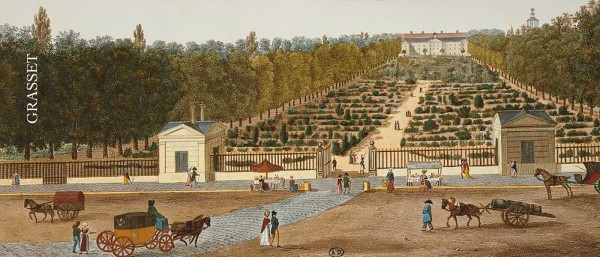
Des cours gratuits, donnés en français et non plus en latin au tout-venant : du jamais vu, qui fait froncer les sourcils à la Sorbonne! Car le succès est immédiat, les carabins s’en donnent à cœur-joie de disséquer des cadavres, de ridiculiser les Diafoirus, de découvrir une sexualité aux plantes: médecine et botanique ne font qu’un au XVIIème siècle et c’est le premier médecin du roi, Guy-Crescent Fagon, qui administre le jardin jusqu’à la fin du règne de Louis XIV.
Au XVIIIème siècle, c’est la surproduction de tout : des espèces végétales, animales et minérales rapportées par ces missions scientifiques qui sillonnent l’univers, des cabinets de curiosité des grands de ce monde, des touristes qui affluent de toute l’Europe au jardin des Plantes pour rencontrer Buffon, l’auteur d’un des best-sellers de son temps, une Histoire naturelle en 36 volumes qui ignore sèchement son contemporain, le savant suédois Carl von Linné dont la classification fait encore autorité.

Nationalisé à la révolution, sauvé par Lakanal qui voit surtout son aspect éducatif, voici le jardin Royal transformé en muséum. Douze professeurs vont chacun occuper une chaire et administrer l’institution pendant deux cents ans et aucun des promeneurs, peintres ou écrivains qui découvrent avec délices au XIXème siècle la ménagerie, les grandes galeries, le jardin d’Acclimatation (1860), au bois de Boulogne, le musée d’Ethnographie, ancêtre du musée de l’Homme, au Trocadéro (1878) ou le zoo de Vincennes (1934) ne se doute des querelles qui agitent les coulisses de l’établissement et se nomment fixisme, transformisme, Darwinisme, colonialisme, adaptation ou refus de la révolution industrielle, déclin scientifique.
L’homme est-il un singe? La France apporte-t-elle aux peuples colonisés l’ombre ou la lumière? A quoi sert le muséum ? Comme la pluie qui tombe dans les grandes galeries, faute de crédits, après la Seconde Guerre mondiale et surtout après les Trente Glorieuses, l’histoire naturelle est-elle en train de tomber dans l’oubli?
L’ADN découvert en 1953, qui révèle tout de vous, de votre passé et de celui du vieux renard empaillé ou de la roche emprisonnée, fait-il encore de nous des être humains ? La numérisation viendra-t-elle à bout du trop plein des musées ? Va-t-elle rendre à leurs pays d’origine tout ce qui en a été emporté? Et la terre qui se décroche par mottes entières sous nos yeux, où va-t-elle? C’est dire qu’au XXIème siècle, le muséum a encore devant lui de beaux jours et de belles promenades parmi les dangers de la terre. « [Celle-ci] peut bien disparaître, disait August Strinberg en 1894, si le jardin des Plantes est épargné, la création sera sauvée. » Puisse l’avenir lui donner raison!
Le Jardin des Plantes
par Elvire de Brissac
Grasset Ed.
Paru le: 10 Janvier 2024
Format: 140 x 205 mm
304 pages
Ean: 9782246837244
Prix: € 22.00
• fleursdumal.nl magazine
More in: - Book News, - Bookstores, Archive A-B, Department of Curious Nature, Natural history, NONFICTION: ESSAYS & STORIES
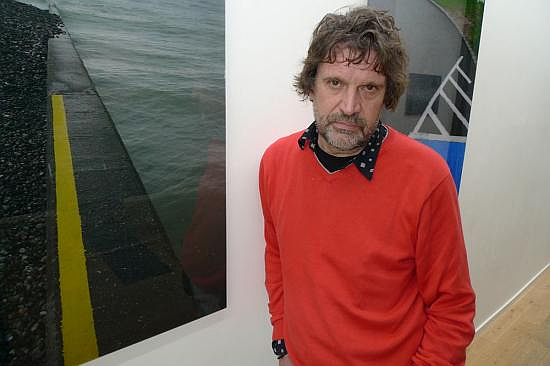
Ernest Potters tijdens zijn eerste solo-tentoonstelling sinds lang, in Luycks Gallery, 2012. (Foto: Joep Eijkens)
Ernest Potters timmerde niet alleen als fotograaf aan de weg, maar was ook jarenlang drijvende kracht en organisator van tal van activiteiten in de Tilburgse kunstwereld. Op 10 augustus 2022 overleed hij na een kort ziekbed.
door Joep Eijkens
Ernest Potters werd in 1953 te Tilburg geboren als zoon van de bekende pottenbakkers Henk en Lies Potters. Hij volgde zijn opleiding aan St. Joost Breda en was sinds 1974 werkzaam als fotograaf/fotojournalist. Vanaf de jaren zeventig werkte hij als freelance fotograaf onder meer voor muziekbladen als OOR en Hitkrant, voor het maandblad Jazz Nu en diverse landelijke dag- en weekbladen. Maar ook voor uiteenlopende (kunst)instellingen en andere opdrachtgevers in Tilburg en daarbuiten, waaronder diverse muziek-, dans- en theatergezelschappen.
Potters fotografeerde talloze theater- en dansvoorstellingen. Tot zijn favoriete onderwerpen hoorden architectuur en muzikanten. Wat dat laatste betreft was hij apetrots op een portret dat hij schoot van zijn idool Frank Zappa.
Ruimte X
Maar Potters was beslist méér dan fotograaf. Zo stichtte hij in 1980 met zijn toenmalige levenspartner, danseres Nora van den Eeckhout, Het Danshuis, gevestigd in de Telexstraat in Tilburg. Het betreffende pand werd later onder de naam Ruimte-X een bekend ‘multidisciplinair kunstenpodium’ waar tussen 1998 en 2012 talloze exposities, voorstellingen en culturele bijeenkomsten plaatsvonden. Potters hoorde bovendien tot degenen die aan de wieg stonden van de succesvolle Werkplaats L’Avventura Tilburg.
Ook kreeg Ernst Potters naam door de kunstexposities die hij elders in de stad organiseerde tijdens de Tilburgse kermis. En door de in literatuur, beeldende kunst, theater en muziek gespecialiseerde uitgeverij teleXpress die hij runde met zijn partner Ingrid Luycks. De producten waren steeds mooi verzorgde publicaties. Zijn eerste foto-expositie had hij in 1976 in het cultureel centrum Boerderij Denissen in Berkel-Enschot. Daarna volgden exposities in binnen- en buitenland.
Qua Vadis
In 2012 sloot Ruimte X de deuren en concentreerde Ernest Potters zich weer meer op zijn werk als fotograaf. Het was in de galerie van Luycks dat hij in datzelfde jaar voor het eerst sinds lange tijd weer solo eigen fotografisch werk exposeerde onder de titel Quo Vadis. Diverse solo- en duo-exposities volgden daarna, eveneens in Luycks Gallery.
Potters timmerde de afgelopen jaren sowieso steviger aan de weg als fotograaf. Zo begon hij eind 2020 op Instagram met een soort dagboek in foto’s van dingen en plekken die hij onderweg tegenkwam. Al dan niet alledaagse voorwerpen en plekken waaraan vrijwel niemand aandacht schenkt: van een weggegooid bierblikje op een hoop straatstenen tot een abstract detail van een stukje architectuur. Alsof hij wilde zeggen dat schoonheid ook op straat is te vinden, als je er maar oog voor hebt.
Ernest Potters maakte ook, en regelmatig in samenwerking met anderen, diverse fotoboeken zoals Hoog-Gaat-Ie. Fotoboek van de Tilburgse kermis met Paul Spapens en Lauran Wijffels, en vorig jaar nog Het nieuwe ritme van Tilburg. Dat was een coproductie met de eveneens Tilburgse fotograaf Wil van Dusseldorp over de metamorfose die de voormalige textielstad onderging sinds de jaren zestig. Potters nam daarin vooral het afgelopen decennium voor zijn rekening, met kleurenfoto’s die hij speciaal voor dit boek maakte. Het werd uitgegeven door stichting De NWE Stijl, waarin Ingrid Luycks één van de drijvende krachten is. Potters was ook de bedenker van tal van opmerkelijke boekconcepten en uitgaven, waaronder De Kanonbal. Requiem voor een wielrenner en dichtbundels van diverse Tilburgse stadsdichters.
Om ideeën zat Ernest Potters nooit verlegen en hij was ook altijd bereid ideeën van anderen de ruimte geven, vaak letterlijk in Ruimte X. Zijn betrokkenheid bij Tilburg was groot en hij zal in die stad worden gemist, maar zijn wereld was eindeloos veel groter dan stad of provincie.
Eerder gepubliceerd in: Brabant Cultureel. Digitaal podium voor kunst en cultuur
© Joep Eijkens, 11 augustus 2022
https://www.brabantcultureel.nl/
•fleursdumal.nl magazine
More in: #Biography Archives, Archive O-P, AUDIO, CINEMA, RADIO & TV, DANCE & PERFORMANCE, In Memoriam, Joep Eijkens, Photography

A Woman’s Game explores the history of women’s football from the Victorian era – with players in high-heeled boots – to the present day. It is the story of a rise, fall, and rise again: from the game’s first appearance in England in the late nineteenth century; through the incredible teams which at their height in 1920 drew 53,000 spectators to Goodison Park; to its 50-year ban in the UK and the aftershocks when that ban was lifted.
Now, as the women’s game is once again on an unstoppable upward trend, with internationally renowned players and a record 11.7m viewers for England’s semi-final match against the USA in the 2019 World Cup, Suzanne Wrack considers what the next chapter of this incredible story might be. From its relationship to the worldwide fight against oppression, to its ability to inspire change in the wider world, this is both a history of football as played by women, and a manifesto for a better game.
Suzanne Wrack is the women’s football correspondent for the Guardian and Observer. Her work has also been published in FourFourTwo, and she is a regular contributor to the Guardian’s Football Weekly podcast. In 2020, her investigation on abuse at the Afghanistan Football Federation won an AIPS Sport Media Award. A Woman’s Game is her first book.
A Woman’s Game
by Suzanne Wrack
The astonishing history of the rise, fall, and rise again of women’s football, from the late 19th century to the present day.
Format Paperback
Faber Publisher
ISBN 9781783352159
Date Published 16.06.2022
£14.99
• fleursdumal.nl magazine
More in: - Book News, - Bookstores, Archive W-X, NONFICTION: ESSAYS & STORIES
Venerated for his lyrics, Bob Dylan in fact is a songwriting musician with a unique mastery of merging his words with music and performance.
 Larry Starr cuts through pretention and myth to provide a refreshingly holistic appreciation of Dylan’s music. Ranging from celebrated classics to less familiar compositions, Starr invites readers to reinvigorate their listening experiences by sharing his own—sometimes approaching a song from a fresh perspective, sometimes reeling in surprise at discoveries found in well-known favorites. Starr breaks down often-overlooked aspects of the works, from Dylan’s many vocal styles to his evocative harmonica playing to his choices as a composer. The result is a guide that allows listeners to follow their own passionate love of music into hearing these songs—and personal favorites—in new ways.
Larry Starr cuts through pretention and myth to provide a refreshingly holistic appreciation of Dylan’s music. Ranging from celebrated classics to less familiar compositions, Starr invites readers to reinvigorate their listening experiences by sharing his own—sometimes approaching a song from a fresh perspective, sometimes reeling in surprise at discoveries found in well-known favorites. Starr breaks down often-overlooked aspects of the works, from Dylan’s many vocal styles to his evocative harmonica playing to his choices as a composer. The result is a guide that allows listeners to follow their own passionate love of music into hearing these songs—and personal favorites—in new ways.
Reader-friendly and revealing, Listening to Bob Dylan encourages hardcore fans and Dylan-curious seekers alike to rediscover the music legend.
Larry Starr is emeritus professor of music history at the University of Washington. He is the author of George Gershwin and coauthor of American Popular Music: From Minstrelsy to MP3, sixth edition.
# non fiction: music
Listening to Bob Dylan
Author: Larry Starr
Experiencing and re-experiencing Dylan’s music
Pages: 160 pages
Dimensions: 6 x 9 in
Paperback – $19.95
978-0-252-08602-1
Publication Date: 10/12/2021
Series: Music in American Life
University of Illinois Press
2021
• fleursdumal.nl magazine
More in: # Music Archive, Archive C-D, Archive C-D, Archive S-T, AUDIO, CINEMA, RADIO & TV, Bob Dylan, Dylan, Bob, NONFICTION: ESSAYS & STORIES
A Washington Post Style editor’s fascinating and irresistible look back on the Miss America pageant as it approaches its 100th anniversary.
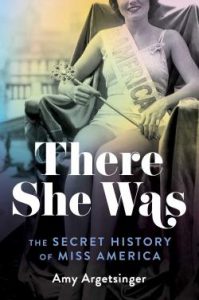 The sash. The tears. The glittering crown. And of course, that soaring song. For all of its pomp and kitsch, the Miss America pageant is indelibly written into the American story of the past century.
The sash. The tears. The glittering crown. And of course, that soaring song. For all of its pomp and kitsch, the Miss America pageant is indelibly written into the American story of the past century.
From its giddy origins as a summer’s-end tourist draw in Prohibition-era Atlantic City, it blossomed into a televised extravaganza that drew tens of millions of viewers in its heyday and was once considered the highest honor that a young woman could achieve.
For two years, Washington Post reporter and editor Amy Argetsinger visited pageants and interviewed former winners and contestants to unveil the hidden world of this iconic institution.
There She Was spotlights how the pageant survived decades of social and cultural change, collided with a women’s liberation movement that sought to abolish it, and redefined itself alongside evolving ideas about feminism.
For its superstars—Phyllis George, Vanessa Williams, Gretchen Carlson—and for those who never became household names, Miss America was a platform for women to exercise their ambitions and learn brutal lessons about the culture of fame. Spirited and revelatory, There She Was charts the evolution of the American woman, from the Miss America catapulted into advocacy after she was exposed as a survivor of domestic violence to the one who used her crown to launch a congressional campaign; from a 1930s winner who ran away on the night of her crowning to a present-day rock guitarist carving out her place in this world. Argetsinger dissects the scandals and financial turmoil that have repeatedly threatened to kill the pageant—and highlights the unexpected sisterhood of Miss Americas fighting to keep it alive.
Amy Argetsinger is an editor and writer for The Washington Post. “There She Was” is her first book.
There She Was:
The Secret History of Miss America
by Amy Argetsinger
Publisher: Atria/One Signal Publishers
September 7, 2021
Language : English
Hardcover : 384 pages
ISBN-10 : 1982123397
ISBN-13 : 978-1982123390
$ 23.49
• fleursdumal.nl magazine
More in: - Book News, - Book Stories, Archive A-B, AUDIO, CINEMA, RADIO & TV, NONFICTION: ESSAYS & STORIES, PRESS & PUBLISHING
Weird Westerns is an exploration of the hybrid western genre—an increasingly popular and visible form that mixes western themes, iconography, settings, and conventions with elements drawn from other genres, such as science fiction, horror, and fantasy.
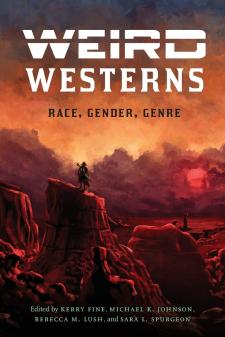 Despite frequent declarations of the western’s death, the genre is now defined in part by its zombie-like ability to survive in American popular culture in weird, reanimated, and reassembled forms.
Despite frequent declarations of the western’s death, the genre is now defined in part by its zombie-like ability to survive in American popular culture in weird, reanimated, and reassembled forms.
The essays in Weird Westerns analyze a wide range of texts, including those by Native American authors Stephen Graham Jones (Blackfeet) and William Sanders (Cherokee); the cult television series Firefly and The Walking Dead; the mainstream feature films Suicide Squad and Django Unchained; the avant-garde and bizarre fiction of Joe R. Lansdale; the tabletop roleplaying game Deadlands: The Weird West; and the comic book series Wynonna Earp.
The essays explore how these weird westerns challenge conventional representations by destabilizing or subverting the centrality of the heterosexual, white, male hero but also often surprisingly reinforce existing paradigms in their inability to imagine an existence outside of colonial frameworks.
Author Bio:
Kerry Fine is an instructor in the Department of English at Arizona State University. Michael K. Johnson is a professor of English at the University of Maine–Farmington. Rebecca M. Lush is an associate professor at California State University, San Marcos. Sara L. Spurgeon is a professor of American literature at Texas Tech University.
Postwestern Horizons:
Postwestern Horizons encourages scholarship which rethinks and reimagines traditional western scholarship by challenging predominant paradigms, including revisionist ones, and dislocating our sense of region. By moving past the West as a national place, process, and idea to more methodologically innovative, transnationally daring, and theoretically fertile horizons of scholarship, this series encourages new ways of conceiving cultural production and reception. Postwestern Horizons encompasses studies of visual culture, environmental studies, literature, history, film studies, and much more.
Weird Westerns
Race, Gender, Genre
Edited by Kerry Fine, Michael K. Johnson, Rebecca M. Lush, and Sara L. Spurgeon
Postwestern Horizons Series
468 pages
Index
Paperback
August 2020
978-1-4962-2178-0
$35.00
Hardcover
August 2020
978-1-4962-2116-2
$70.00
# new books
Weird Westerns.
Race, Gender, Genre
• fleursdumal.nl magazine
More in: - Book News, - Bookstores, Art & Literature News, AUDIO, CINEMA, RADIO & TV, NONFICTION: ESSAYS & STORIES, Western Non-Fiction
In ‘Zij namen het woord’ schetst Margot Dijkgraaf de portretten van uitzonderlijke, schrijvende Franse vrouwen uit de 17e tot de 21e eeuw.
 Ze schrijven, ze spreken, ze gaan de barricaden op, ze doorbreken taboes, ze verleggen grenzen. En ze bieden inspiratie – door hun boeken, hun denkbeelden, hun daden of hun karakter.
Ze schrijven, ze spreken, ze gaan de barricaden op, ze doorbreken taboes, ze verleggen grenzen. En ze bieden inspiratie – door hun boeken, hun denkbeelden, hun daden of hun karakter.
De vrouwen in dit boek heten Colette of Françoise Sagan, George Sand of Simone de Beauvoir, Madame de Staël of Maryse Condé.
De een is grondlegger van de Europese literatuur, de volgende vecht voor de positie van de vrouw als schrijfster, weer een ander richt haar pijlen op onrechtvaardigheid en ongelijkheid of eist voor de niet-westerse stem een plek op in de literatuur.
Allemaal zijn ze Franstalig, rebels, tegendraads. Schrijven is gevaarlijk.
Margot Dijkgraaf
Zij namen het woord
Pagina’s: 240
Paperback / softback
Gepubliceerd: februari 2020
ISBN 9789045040998
Uitg. Atlas-Contact
€ 19,99
# new books
Margot Dijkgraaf
Zij namen het woord
• fleursdumal.nl magazine
More in: - Book News, - Book Stories, - Bookstores, Archive C-D, Art & Literature News, Margot Dijkgraaf, NONFICTION: ESSAYS & STORIES, The Ideal Woman
Antony Kok
schrijver en experimenteel dichter
door Jef van Kempen
Antony Kok werd op 18 april 1882 in Rotterdam geboren, als zoon van Pieter Kok en Sophia Hagen. Zijn vader was adjunct-commies bij de Staatsspoorwegen. Antony Kok overleed op 29 oktober 1969 te Haarlem.
 Het grootste deel van zijn jeugd woonde Antony Kok in het Limburgse Maasbree. Na zijn middelbare schooltijd trad hij in het voetspoor van zijn vader door in 1899 ook bij de Staatsspoorwegen te gaan werken. Na eerst in ‘s-Hertogenbosch en Oisterwijk als klerk-telegrafist te hebben gewerkt kwam hij in 1908 naar Tilburg, waar hij het na verloop van tijd tot chef-commies zou brengen.
Het grootste deel van zijn jeugd woonde Antony Kok in het Limburgse Maasbree. Na zijn middelbare schooltijd trad hij in het voetspoor van zijn vader door in 1899 ook bij de Staatsspoorwegen te gaan werken. Na eerst in ‘s-Hertogenbosch en Oisterwijk als klerk-telegrafist te hebben gewerkt kwam hij in 1908 naar Tilburg, waar hij het na verloop van tijd tot chef-commies zou brengen.
De eerste tien jaar woonde Kok, die zijn hele leven ongehuwd bleef, op kamers boven slagerij De Brouwer in de Tuinstraat. Hij zou in Tilburg later nog vier maal verhuizen.
In 1914 raakte Antony Kok bevriend met de Amsterdamse schrijver en schilder Theo van Doesburg, die tijdens de mobilisatie in de omgeving van Tilburg was gelegerd. Samen organiseerden zij in 1915 tweemaal een Soiree Intime, waarbij Van Doesburg gedichten voordroeg en Kok piano speelde. Onder invloed van Van Doesburg experimenteerde Kok dat jaar, als een van de eersten in Nederland, met het schrijven van klankpoëzie.
In die tijd ontstonden ook plannen voor het oprichten van een eigen tijdschrift, waarin zij hun opvattingen over de moderne beeldende kunst en literatuur zouden kunnen ventileren. Dat tijdschrift werd De Stijl, dat van 1917 tot 1932 verscheen en ook internationaal gezien een van de belangrijkste organen zou blijken voor de vernieuwing van met name beeldende kunst en architectuur. Behalve Van Doesburg en Kok behoorden tot de oprichters ook de schilders Huszàr, Van der Leck en Mondriaan, en de architecten Oud en Wils. Zij wilden de beeldende kunst ontdoen van alle overbodige versieringen en zich beperken tot het gebruik van de rechte lijn en de primaire kleuren.
Antony Kok debuteerde in 1917 met zijn gedicht Excelsior in het tijdschrift Eenheid. In hetzelfde tijdschrift publiceerde hij later nog de gedichten De Rozelaar (1917) en Gods Licht (1918). Verder werd in 1917 Koks experimentele gedicht De Wisselwachter in het tijdschrift Holland Express afgedrukt.
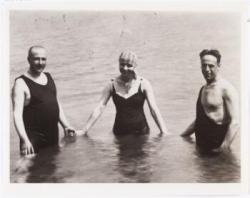 In het eerste nummer van De Stijl van oktober 1917 nam Van Doesburg een beschouwing van zijn Tilburgse vriend op met de titel: De moderne schilderij in het interieur.
In het eerste nummer van De Stijl van oktober 1917 nam Van Doesburg een beschouwing van zijn Tilburgse vriend op met de titel: De moderne schilderij in het interieur.
Antony Kok zou in de loop van de tijd meer beschouwend proza in De Stijl publiceren, zoals Scheppen (1918), Denkextracten. Over organische schoonheid en Kunst en ontroering. Synthetische analyse (1919).
Hij was ook een van de ondertekenaars van de door Stijl-medewerkers gepubliceerde manifesten over beeldende kunst (1918) en literatuur (1920). Van Kok werden in het tijdschrift De Stijl maar twee gedichten opgenomen: in 1921 Stilte + stem (Vers in W) en in 1923 het acht jaar eerder geschreven Nachtkroeg. De beide gedichten, die voor het grootste deel bestonden uit klanknabootsende woorden, werden niet alleen door Theo van Doesburg, maar ook door Piet Mondriaan en Kurt Schwitters beschouwd als een belangrijke bijdrage tot de vernieuwing van de dichtkunst.
Schwitters nam het gedicht Stilte + stem (Vers in W) ook op in zijn eigen tijdschrift Merz. Geïnspireerd door Schwitters schreef Kok in 1923 een aantal dadaïstische gedichten, die echter pas na zijn dood werden gepubliceerd. Het overlijden van Theo van Doesburg in 1931 betekende het einde van het tijdschrift De Stijl.
In 1932 zou er nog een laatste aflevering verschijnen met daarin een In memoriam van de hand van Kok; dat zou tevens zijn laatste publicatie zijn. De omvangrijke briefwisseling tussen Van Doesburg en Kok is een van de belangrijkste bronnen met betrekking tot de geschiedenis van de beweging rond het tijdschrift De Stijl.
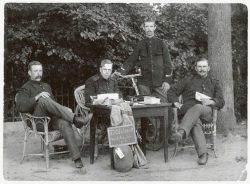 Antony Kok stond bekend als een bedachtzaam en vrijgevig man. Hij was een groot kunstminnaar en een mecenas, niet alleen voor bijvoorbeeld Piet Mondriaan maar ook voor regionale kunstenaars. In de jaren na het overlijden van zijn vriend Theo van Doesburg schreef hij nog zelden gedichten, maar legde zich geheel toe op het schrijven van aforismen.Tot aan zijn dood zou hij er vele duizenden schrijven, die hijzelf echter nooit heeft gepubliceerd.
Antony Kok stond bekend als een bedachtzaam en vrijgevig man. Hij was een groot kunstminnaar en een mecenas, niet alleen voor bijvoorbeeld Piet Mondriaan maar ook voor regionale kunstenaars. In de jaren na het overlijden van zijn vriend Theo van Doesburg schreef hij nog zelden gedichten, maar legde zich geheel toe op het schrijven van aforismen.Tot aan zijn dood zou hij er vele duizenden schrijven, die hijzelf echter nooit heeft gepubliceerd.
In 1942 ging Antony Kok met pensioen bij de spoorwegen. De jaren daarna zou hij zijn belangstelling voor het spiritisme en de filosofie verder cultiveren en zich in 1946 aansluiten bij de beweging van De Rozenkruisers. Ter wille van die beweging verhuisde hij in 1952 naar Haarlem. In deze stad maakte Kok kennis met de schilder Kees Verweij, die ruim veertig portretten van hem maakte. De tekeningen, die door Kok van een titel waren voorzien, werden tentoongesteld, onder andere in het Stedelijk Museum Amsterdam en het Van Abbemuseum in Eindhoven (1954-1955).
Op 29 oktober 1969 overleed Antony Kok op 87-jarige leeftijd. De meeste publicaties van en over zijn werk kwamen na zijn dood tot stand. Als gevolg van de toegenomen belangstelling voor zijn werk en zijn persoon, werd begin 1985 in de Stadsschouwburg/Kultureel Sentrum van Tilburg nog een grote tentoonstelling aan de ‘Dichter bij De Stijl‘ gewijd.
Meer informatie over Antony Kok op website: www.antonykok.nl
Dit artikel verscheen eerder in: J. van Oudheusden, e.a. (red.), Brabantse biografieën. Levensbeschrijvingen van bekende en onbekende Noordbrabanders. Deel 1, Amsterdam/Meppel, 1992.
Verder gepubliceerd op 14 september 2017 op de website Brabants Erfgoed: https://www.brabantserfgoed.nl/
Op 29 oktober 2019 is het precies 50 jaar geleden dat Antony Kok, schrijver en experimenteel dichter, overleed in een Haarlems ziekenhuisbed.
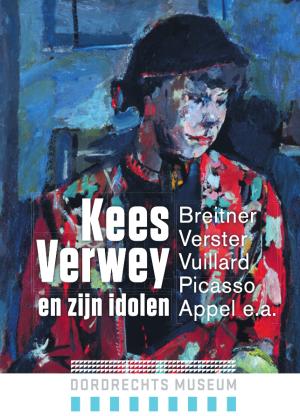 Tot en met 5 januari 2020 is er een expositie te zien in het Dordrechts Museum over de Haarlemse kunstschilder Kees Verwey, onder de titel: Kees Verwey en zijn idolen. Hier zijn ook 30 portretten te zien van Antony Kok (gemaakt door Verwey) uit de collectie van het Rijksmuseum.
Tot en met 5 januari 2020 is er een expositie te zien in het Dordrechts Museum over de Haarlemse kunstschilder Kees Verwey, onder de titel: Kees Verwey en zijn idolen. Hier zijn ook 30 portretten te zien van Antony Kok (gemaakt door Verwey) uit de collectie van het Rijksmuseum.
Bij deze expositie in Museum Dordrecht, verscheen de publicatie: Kees Verwey en zijn idolen.
Één van de hoofdstukken heeft als titel: ‘Antony Kok had me te pakken’ en is geschreven door de Antony Kok biografen Hanneke van Kempen en Jef van Kempen.
Kees Verwey en zijn idolen
Dordrechts Museum
2019
ISBN 978-90-71722-30-1
Redactie: Laura van den Hout, Judith Spijksma, Linda Janssen
‘Antony Kok had me te pakken’ door Hanneke van Kempen en Jef van Kempen geeft een beeld van de gang van zaken rond de vriendschap van Antony Kok en de Haarlemse schilder Kees Verwey en is geïllustreerd.
https://www.dordrechtsmuseum.nl/
antonykok.nl magazine
fleursdumal.nl magazine
29 oktober 2019

More in: Agnita Feis, Antony Kok, Archive K-L, DADA, De Stijl, Essays about Van Doesburg, Kok, Mondriaan, Schwitters, Milius & Van Moorsel, Evert en Thijs Rinsema, Hanneke van Kempen, Jef van Kempen, Kurt Schwitters, Kurt Schwitters, Literaire sporen, Piet Mondriaan, Theo van Doesburg, Theo van Doesburg
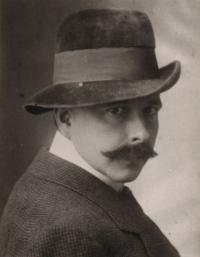 Antony Kok (1882 – 1969)
Antony Kok (1882 – 1969)
Antony Kok, was met Theo van Doesburg en Piet Mondriaan oprichter en medewerker van het avant-gardistische kunsttijdschrift De Stijl (1917 – 1932). Hij was vooral actief als dichter en schrijver van aforismen.
Kees Verwey (1900 -1995)
Tijdens zijn leven, dat bijna een eeuw beslaat, maakte de kunstenaar verschillende ontwikkelingen in de schilderkunst mee. Al op jonge leeftijd kwam hij in aanraking met het werk van George Breitner en Floris Verster. Ook werd hij beïnvloed door Franse (post-)impressionisten en later door de moderne kunst van o.a. Karel Appel en Pablo Picasso. Omringd door de kunst van zijn idolen wordt in deze nieuwe tentoonstelling de enorme vaardigheid en veelzijdigheid van de schilder Verwey duidelijk.
Na hun ontmoeting (in Haarlem in 1953) verklaarde Kees Verwey:
‘Antony Kok had me te pakken. Ruim een jaar ben ik met die ene man bezig geweest. Je zou zeggen dat zoiets ondenkbaar is, maar ik kon niet buiten de visie op die man. Het was een proces dat niet meer kon worden tegengehouden. Ik heb hem er wel eens over ondervraagd, toen zei hij: maar jij hebt die tekeningen niet gemaakt, ik heb ze gemaakt.’
In het eerste jaren van hun kennismaking maakte Verwey meer dan 30 portretten van Kok. De eerste serie zou begin jaren vijftig worden tentoongesteld in Amsterdam, Rotterdam en Haarlem. In 1955 was de serie uitgegroeid tot 40×1 en in Eindhoven te zien.
Lees meer over Kees Verwey, zijn vrienden en favoriete kunstenaars, zoals Karel Appel, Pablo Picasso, Edouard Vuillard, Floris Verster en Antony Kok in de bij de tentoonstelling verschenen publicatie:
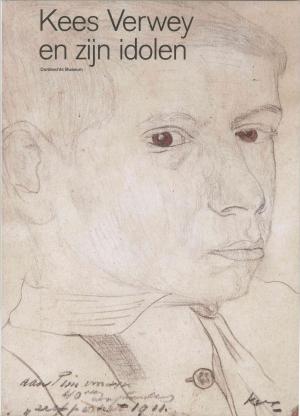
Kees Verwey
en zijn idolen
Dordrechts Museum
2019
ISBN 978-90-71722-30-1
Redactie: Laura van den Hout, Judith Spijksma, Linda Janssen
Publicatie ter gelegenheid van de tentoonstelling ‘Kees Verwey en zijn idolen’, die van 14 juli 2019 tot en met 5 januari 2020 plaatsvindt in het Dordrechts Museum. De tentoonstelling kwam tot stand in samenwerking met Stichting Kees Verwey.
I N H O U D
6
Max van Rooy
Portretten als stillevens en het atelier als goudmijn
12
Karlijn de Jong
De moeder van de moderne kunst
Kees Verwey en De Onafhankelijken
22
Tijdlijn
26
Barbara Collé
Kijk ik naar de een, dan vlamt de ander
Over kleurenparen in Moeders theetafel en Het gele jakje van Kees Verwey, en Stilleven met boeken van Henri Frédéric Boot
34
Iduna Paalman
Sigaretje
36
Ester Naomi Perquin
Bes
38
Maartje Smits
Door je kind getekend
40
Maarten Buser
Pirouettes draaien op een idee
Kees Verwey en de literatuur
46
Jorne Vriens
Gekoesterde intimiteit
50
Max van Rooy
De onderzoekende kracht van het kijken
54
Sascha Broeders
De kunstenaar en de museumdirecteur
Kees Verwey volgens Jup de Groot, voormalig directeur van het Dordrechts Museum
56
Hanneke van Kempen en Jef van Kempen
‘Antony Kok had me te pakken’
66
Sandra Kisters
Het atelier van Kees Verwey – een kristal met vele facetten
75
Biografieën
76
Colofon
Tentoonstelling van 6 juli 2019 t/m 5 januari 2020
Kees Verwey en zijn idolen
Over Karel Appel, Pablo Picasso, Edouard Vuillard, Floris Verster, Antony Kok e.a.
Dordrechts Museum
Museumstraat 40, Dordrecht
3311 XP Dordrecht
www.dordrechtsmuseum.nl
‘Antony Kok had me te pakken’ sprak Kees Verwey
fleursdumal.nl magazine
More in: - Book News, - Book Stories, Antony Kok, Archive K-L, Archive W-X, Art & Literature News, DADA, Dada, De Stijl, Exhibition Archive, FDM Art Gallery, Hanneke van Kempen, Jef van Kempen, Kees Verwey, Kok, Antony, Piet Mondriaan, Theo van Doesburg
From blogger Heather B. Armstrong (dooce), author of It Sucked and Then I Cried, comes The Valedictorian of Being Dead (Gallery), an irreverent new memoir – reminiscent of Brain on Fire – about her experience as one of only a few people to participate in an experimental treatment for depression involving 10 rounds of a chemically-induced coma approximating brain death.
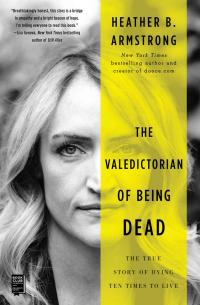 For years, Heather Armstrong has alluded to her struggle with depression on her website, dooce. It’s scattered throughout her archive, where it weaves its way through posts about pop culture, music, and motherhood. But in 2016, Heather found herself in the depths of a depression she just couldn’t shake, an episode darker and longer than anything she had previously experienced. She had never felt so discouraged by the thought of waking up in the morning, and it threatened to destroy her life. So, for the sake of herself and her family, Heather decided to risk it all by participating in an experimental clinical trial involving a chemically induced coma approximating brain death.
For years, Heather Armstrong has alluded to her struggle with depression on her website, dooce. It’s scattered throughout her archive, where it weaves its way through posts about pop culture, music, and motherhood. But in 2016, Heather found herself in the depths of a depression she just couldn’t shake, an episode darker and longer than anything she had previously experienced. She had never felt so discouraged by the thought of waking up in the morning, and it threatened to destroy her life. So, for the sake of herself and her family, Heather decided to risk it all by participating in an experimental clinical trial involving a chemically induced coma approximating brain death.
Now, for the first time, Heather recalls the torturous eighteen months of suicidal depression she endured and the month-long experimental study in which doctors used propofol anesthesia to quiet all brain activity for a full fifteen minutes before bringing her back from a flatline. Ten times. The experience wasn’t easy. Not for Heather or her family. But a switch was flipped, and Heather hasn’t experienced a single moment of suicidal depression since.
Disarmingly honest, self-deprecating, and scientifically fascinating, The Valedictorian of Being Dead brings to light a groundbreaking new treatment for depression.
Author: Heather B. Armstrong
The Valedictorian of Being Dead:
The True Story of Dying Ten Times to Live
Binding: Hardcover
Publication date: 04/23/2019
Publisher: SIMON & SCHUSTER TRADE
Pages: 272
ISBN13: 9781501197048
ISBN10: 1501197045
List Price $26.00
# new books
Heather B. Armstrong
The Valedictorian of Being Dead
• fleursdumal.nl magazine
More in: - Book News, Archive A-B, DRUGS & DISEASE & MEDICINE & LITERATURE, MONTAIGNE, NONFICTION: ESSAYS & STORIES
The final book from one of Europe’s cultural giants: an entertaining collection of essays about the modern world – from unbridled individualism to mobile phones.
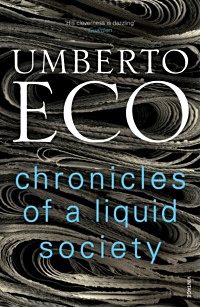 Umberto Eco was an international cultural superstar. A celebrated essayist as well as novelist, in this, his last collection, he explores many aspects of the modern world with irrepressible curiosity and wisdom written in his uniquely ironic voice.
Umberto Eco was an international cultural superstar. A celebrated essayist as well as novelist, in this, his last collection, he explores many aspects of the modern world with irrepressible curiosity and wisdom written in his uniquely ironic voice.
Written by Eco as articles for his regular column in l’Espresso magazine, he brings his dazzling erudition, incisiveness and keen sense of the everyday to bear on topics such as popular culture and politics, unbridled individualism, conspiracies, the old and the young, mobile phones, mass media, racism, good manners and the crisis in ideological values.
It is a final gift to his readers – astute, witty and illuminating.
“ A swan song from one of Europe’s great intellectuals…Eco entertains with his intellect, humor, and insatiable curiosity…there’s much here to enjoy and ponder ”. Tim Parks, Guardian
Chronicles of a Liquid Society
by Umberto Eco
Paperback
ISBN 9781784705206
Hardback
ISNB 9781911215318
2017/2018
Harvill Secker / Vintage
320 pages
Language & Literary Studies
# New books
Chronicles of a Liquid Society
by Umberto Eco
• fleursdumal.nl magazine
More in: - Book News, - Bookstores, Archive E-F, Art & Literature News, AUDIO, CINEMA, RADIO & TV, DICTIONARY OF IDEAS, MONTAIGNE, Museum of Literary Treasures, NONFICTION: ESSAYS & STORIES, Umberto Eco
Thank you for reading Fleurs du Mal - magazine for art & literature